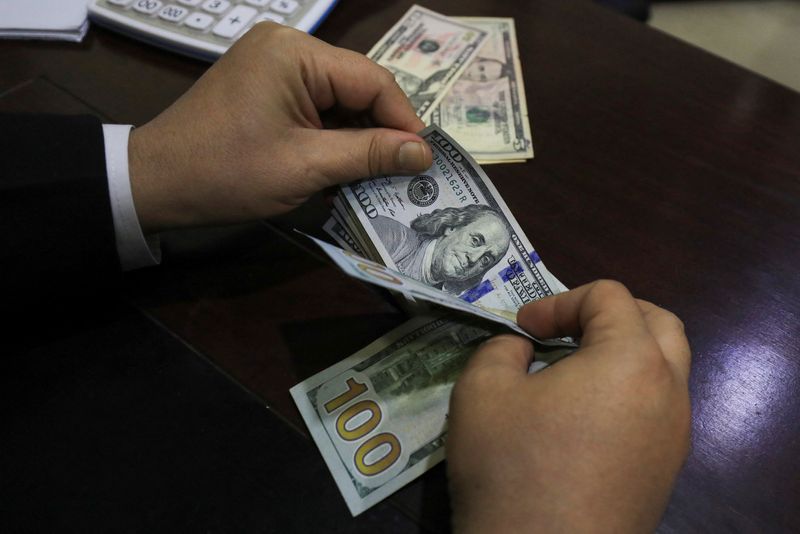Forex
Dollar falls as markets ponder proposed Trump tariffs, US data in focus

By Stefano Rebaudo
(Reuters) – The U.S. dollar was close to a one-week low on Tuesday as markets await U.S. economic data while assessing whether President-elect Donald Trump’s policies on tariffs will align with his rhetoric.
Investors have been pricing in a scenario where the implementation of widespread tariffs could boost U.S. inflation, potentially limiting the Federal Reserve’s ability to cut interest rates and thereby supporting the dollar’s strength.
Now, they are wondering whether officials are preparing to water down some of Trump’s campaign promises, while a lot of uncertainty remains about future moves in U.S. policy.
Trump on Monday denied a Wall Street Journal report that said his aides were exploring tariff plans that would only cover critical imports.
The market focus will shift to U.S. JOLTS job opening data and the ISM Services index for December later in the session.
The , which gauges the currency against the euro, sterling and four other rivals, eased 0.22% to 108.03, after dropping to as low as 107.74 overnight, its weakest since Dec. 30.
On Jan. 2, the index hit a high of 109.58 for the first time since November 2022, largely due to expectations that Trump’s promised fiscal stimulus, reduced regulation and higher tariffs would boost U.S. growth.
“With numerous large policy shifts on the horizon, markets should be prepared for a lot more volatility ahead,” said George Saravelos, head of global forex strategy at Deutsche Bank (ETR:).
On tariffs specifically, “there are likely to be multiple overlapping legislative and executive initiatives with rolling deadlines and announcements throughout the year,” he added.
The euro zone has been a particular target of Trump’s tariff threats, and the euro added 0.18% to $1.0409, after jumping to a one-week high of $1.0437 on Monday.
“While Trump’s rebuttal of the original (Wall Street Journal) article has curtailed the euro/dollar bounce, some doubt about the potential breadth of the tariffs could see an overbought dollar hand back a little more of its recent gains,” said Chris Turner, global head of markets at ING.
“We see no need to change our euro/dollar forecast profile of a gentle grind towards 1.02 this year,” he added, recalling that the European Central Bank is expected to cut rates more quickly than the Fed.
Inflation in the 20 nations sharing the euro picked up to 2.4% last month from 2.2% in November, Eurostat said on Tuesday.
Meanwhile, euro zone households increased their inflation expectations in November, an ECB poll showed.
Money markets priced in an ECB deposit facility rate at 2.1% in July, unchanged after data, from 1.9% before Christmas. The depo rate is currently at 3%.
“The continued stickiness of services inflation means that the ECB is likely to keep cutting interest rates only slowly even as the economic outlook remains poor,” said Jack Allen-Reynolds, deputy chief euro zone economist at Capital Economics.
The dollar gained 0.04% to reach 157.69 yen, and earlier rose as high as 158.425 yen for the first time since July 17, drawing support from higher U.S. Treasury yields.
The yen may have also been sold as investors adjusted positions at the start of the new year, said Shinichiro Kadota, a currency strategist at Barclays (LON:), who forecasts the dollar to be at 158 yen at end-March.
The Canadian dollar rose 0.1% to 1.4315 versus the greenback as Canadian Prime Minister Justin Trudeau said on Monday he would step down in the coming months.
Analysts said former central banker Mark Carney would be the most market-friendly candidate.
Still, they reckoned the domestic political shake-up would not be enough to support the Canadian dollar as the currency outlook remains tied to U.S. tariff policies.

The risk-sensitive Australian and New Zealand dollars resumed their climbs, with the up 0.48% at $0.6276 and the up 0.63% at $0.5679.
In cryptocurrencies, bitcoin was down 0.9% at $100,766, after trading at its highest levels since Dec. 19.

 Forex3 years ago
Forex3 years agoForex Today: the dollar is gaining strength amid gloomy sentiment at the start of the Fed’s week

 Forex3 years ago
Forex3 years agoUnbiased review of Pocket Option broker

 Forex3 years ago
Forex3 years agoDollar to pound sterling exchange rate today: Pound plummeted to its lowest since 1985

 Forex3 years ago
Forex3 years agoHow is the Australian dollar doing today?

 Cryptocurrency3 years ago
Cryptocurrency3 years agoWhat happened in the crypto market – current events today

 World3 years ago
World3 years agoWhy are modern video games an art form?

 Commodities3 years ago
Commodities3 years agoCopper continues to fall in price on expectations of lower demand in China

 Economy3 years ago
Economy3 years agoCrude oil tankers double in price due to EU anti-Russian sanctions





















